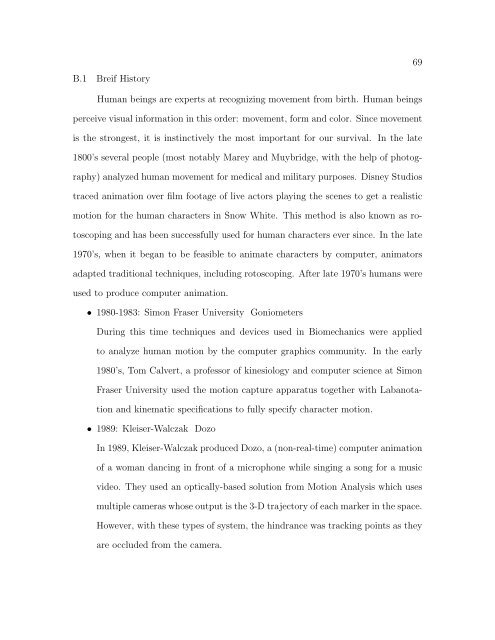A COMPARISON AND EVALUATION OF MOTION INDEXING ...
A COMPARISON AND EVALUATION OF MOTION INDEXING ...
A COMPARISON AND EVALUATION OF MOTION INDEXING ...
You also want an ePaper? Increase the reach of your titles
YUMPU automatically turns print PDFs into web optimized ePapers that Google loves.
B.1 Breif History<br />
Human beings are experts at recognizing movement from birth. Human beings<br />
perceive visual information in this order: movement, form and color. Since movement<br />
is the strongest, it is instinctively the most important for our survival. In the late<br />
1800’s several people (most notably Marey and Muybridge, with the help of photog-<br />
raphy) analyzed human movement for medical and military purposes. Disney Studios<br />
traced animation over film footage of live actors playing the scenes to get a realistic<br />
motion for the human characters in Snow White. This method is also known as ro-<br />
toscoping and has been successfully used for human characters ever since. In the late<br />
1970’s, when it began to be feasible to animate characters by computer, animators<br />
adapted traditional techniques, including rotoscoping. After late 1970’s humans were<br />
used to produce computer animation.<br />
• 1980-1983: Simon Fraser University Goniometers<br />
During this time techniques and devices used in Biomechanics were applied<br />
to analyze human motion by the computer graphics community. In the early<br />
1980’s, Tom Calvert, a professor of kinesiology and computer science at Simon<br />
Fraser University used the motion capture apparatus together with Labanota-<br />
tion and kinematic specifications to fully specify character motion.<br />
• 1989: Kleiser-Walczak Dozo<br />
In 1989, Kleiser-Walczak produced Dozo, a (non-real-time) computer animation<br />
of a woman dancing in front of a microphone while singing a song for a music<br />
video. They used an optically-based solution from Motion Analysis which uses<br />
multiple cameras whose output is the 3-D trajectory of each marker in the space.<br />
However, with these types of system, the hindrance was tracking points as they<br />
are occluded from the camera.<br />
69
















